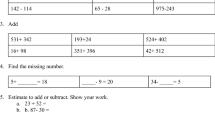Abstract
Recent years have seen a quick expansion of tablet computers in households and schools. One of the educational affordances of tablet computers is using math apps to engage students in mathematics learning. However, given the short history of the mobile devices, little research exists on the effectiveness of math apps, particularly for struggling students. To fill in the gap, an exploratory study was conducted in an inclusive fourth grade classroom, in which about half of the students were either at-risk or had disabilities. The students used three math apps that employed different scaffolding strategies to support learning of decimals and multiplication. Pre- and post-tests showed that use of the math apps improved student learning in mathematics and reduced the achievement gap between struggling students and typical students. More studies should be conducted to identify effective math apps.
Similar content being viewed by others
References
Apple Press. (2013, May 16). Apple’s App Store marks historic 50 billionth download. Retrieved from http://www.apple.com/pr/library/2013/05/16Apples-App-Store-Marks-Historic-50-Billionth-Download.html
Baker, S., Gersten, R., & Lee, D.-S. (2002). A synthesis of empirical research on teaching mathematics to lowachieving students. The Elementary School Journal, 103(1), 51-73.
Barringer, M.-D., Pohlman, C., & Robinson, M. (2010). Schools for all kinds of minds: Boosting student success by embracing learning variation. San Francisco, CA: Jossey-Bass.
Brosvic, G. M., Dihoff, R. E., Epstein, M. L., & Cook, M. L. (2006). Feedback facilitates the acquisition and retention of numerical fact series by elementary school students with mathematics learning disabilities. Psychological Record, 56(1), 35.
Burns, M. K., Kanive, R., & DeGrande, M. (2012). Effect of a computer-delivered math fact intervention as a supplemental intervention for math in third and fourth grades. Remedial and Special Education, 33(3), 184-191.
Carpenter, T. P., Levi, L., Berman, P., & Pligge, M. (2005). Developing algebraic reasoning in the elementary school. In T. A. Romberg, T. P. Carpenter & F. Dremock (Eds.), Understanding mathematics and science matters (pp. 81-98). Mahwah, NJ: Erlbaum.
Chang, W.-L., Yuan, Y., Lee, C.-Y., Chen, M.-H., & Huang, W.-G. (2013). Using Magic Board as a teaching aid in third grader learning of area concepts. Educational Technology & Society, 16(2), 163-173.
Cheung, A., & Slavin, R. E. (2013). The effectiveness of educational technology applications on mathematics achievement in K-12 classrooms: A meta-analysis. Educational Research Review, 9, 88-113.
Geist, E. A. (2012). A qualitative examination of two yearolds interaction with tablet based interactive technology. Journal of Instructional Psychology, 39(1), 26-35.
Hattie, J., & Timperley, H. (2007). The power of feedback. Review of Educational Research, 77, 81-112.
Haydon, T., Hawkins, R., Denune, H., Kimener, L., McCoy, D., & Basham, J. (2012). A comparison of iPads and worksheets on math skills of high school students with emotional disturbance. Behavioral Disorders, 37(4), 232-243.
Hill, D. (2008, October 31). Android Market, Unleashed. Retrieved from http://www.medialets.com/androidmarket-unleashed/
iDevBooks. (2012). Long Multiplication (Version 2.3) [Mobile application software]. Retrieved from http://itunes.apple.com
Kirby, K. D. d. (2013, April). The development of an idealized number line: Differentiating physical inscription from mathematical object. Paper presented at the annual meeting of American Educational Research Association, San Francisco, CA.
Li, Q., & Ma, X. (2010). A meta-analysis of the effects of computer technology on school students’ mathematics learning. Educational Psychology Review, 22(3), 215-243.
Martinie, S. (2013, April). Decimal fractions: An important point. Paper presented at the annual meeting of American Educational Research Association, San Francisco, CA.
Motion Math. (2012). Motion Math: Zoom Pro (Version 1.0) [Mobile application software]. Retrieved from http://itunes.apple.com
National Center for Education Statistics. (2013). National Assessment of Educational Progress (NAEP), various years, 1990-2013 Mathematics Assessments. Washington, D.C.: U.S. Department of Education, Institute of Education Sciences.
National Council of Teachers of Mathematics. (2000). Principles and standards for mathematics education. Reston: National Council of Teachers of Mathematics.
National Governors Association Center for Best Practices & Council of Chief State School Officers. (2010). Common Core State Standards for Mathematics. Washington, D. C.: Authors.
Paek, S., Saravanos, A., & Black, J. B. (2012, April). Studying the impact of input method on the modality principle. Paper presented at the annual meeting of American Educational Research Association, Vancouver, British Columbia, Canada.
Peluso, D. C. C. (2012). The fast-paced iPad revolution: Can educators stay up to date and relevant about these ubiquitous devices? British Journal of Educational Technology, 43(4), E125-E127.
Pilli, O., & Aksu, M. (2013). The effects of computer-assisted instruction on the achievement, attitudes and retention of fourth grade mathematics students in North Cyprus. Computers & Education, 62(0), 62-71.
Rathouz, M. M. (2011). Making sense of decimal multiplication. Mathematics Teaching in the Middle School, 16(7), 430-437.
Saxe, G. B. (2012, April). Learning mathematics through representations: Overview. Paper presented at the annual meeting of American Educational Research Association, Vancouver, British Columbia, Canada.
Segal, A. (2011). Do gestural interfaces promote thinking? Embodied interaction: Congruent gestures and direct touch promote performance in math. Unpublished dissertation, Columbia University, New York.
Slavin, R. E., & Lake, C. (2008). Effective programs in elementary mathematics: A best evidence synthesis. Review of Educational Research, 78(3), 427-515.
Steckroth, J. J. (2010). From calculating to calculus. Teaching Children Mathematics, 16(5), 292-299.
StudyPad. (2012). 4th Grade Math: Splash Math Worksheets
Game for Kids (Version 2.4.0) [Mobile application software]. Retrieved from http://itunes.apple.com
Vaughn, S., Wanzek, J., Murray, C. S., & Roberts, G. (2012). Intensive interventions for students struggling in reading and mathematics: A practice guide. Portsmouth, NH: RMC Research Corporation, Center on Instruction.
Yeh, S. S. (2010). The cost effectiveness of 22 approaches for raising student achievement. Journal of Education Finance, 36(1), 38-75.
Zisimopoulos, D. A. (2010). Enhancing multiplication performance in students with moderate intellectual disabilities using Pegword mnemonics paired with a picture fading technique. Journal of Behavioral Education, 19(2), 117-133.
Author information
Authors and Affiliations
Corresponding author
Rights and permissions
About this article
Cite this article
Zhang, M., Trussell, R.P., Gallegos, B. et al. Using Math Apps for Improving Student Learning: An Exploratory Study in an Inclusive Fourth Grade Classroom. TECHTRENDS TECH TRENDS 59, 32–39 (2015). https://doi.org/10.1007/s11528-015-0837-y
Published:
Issue Date:
DOI: https://doi.org/10.1007/s11528-015-0837-y




